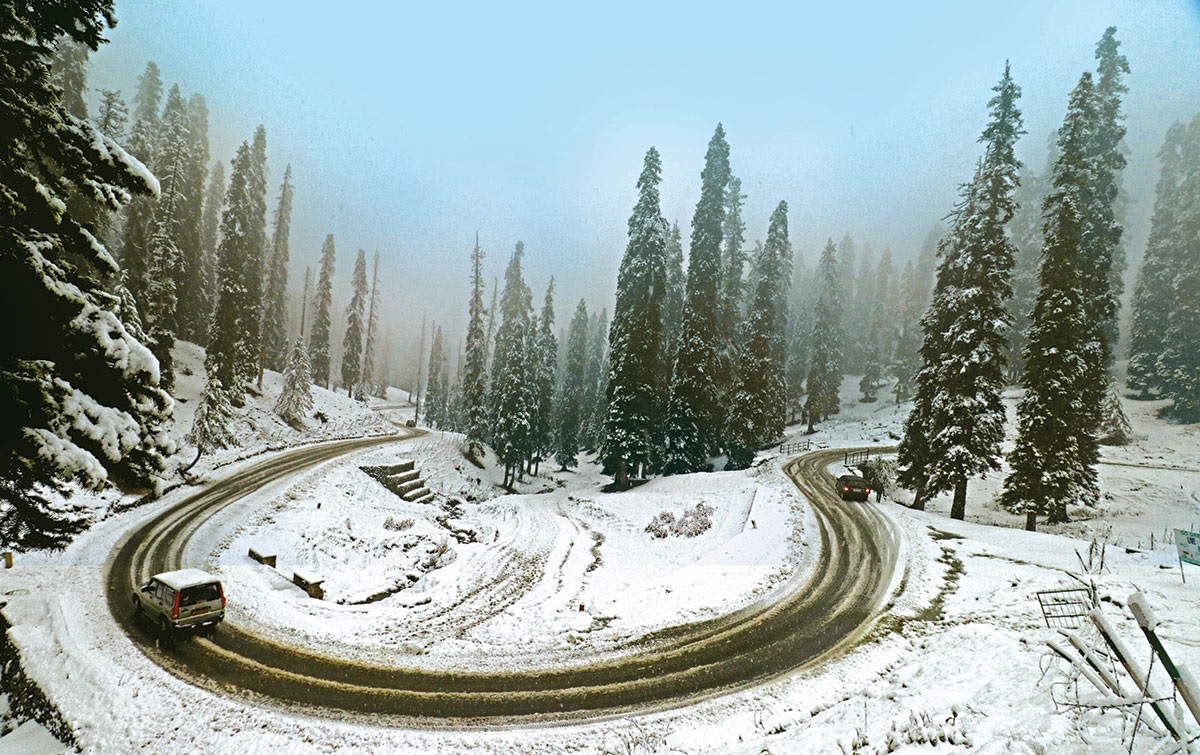As equations changed with time, the lodge housing the erstwhile Prime Minister of Kashmir was acquired by the man whose father happened to build it for the top executive. Shakir Mir reports the new-age hotelier’s ambitious plans for the heritage hut

Past the sprawling Army high-altitude base camp in Gulmarg, a 20-minute arduous trekking down South greets with sparkling wilderness. Amid the dense Pine and Fir forests, a handful of huts – some of which are emblazoned with the camouflage patterns implying their association with army – dot the breathtaking landscape.
A little further, a decrepit wooden cottage looms gregariously in the midst of the vast expanse. Paint from its paneled walls has come off. The window panes are shielded against the sunlight and bad weather by the broad wooden sheaths. Elsewhere in the structure, swarms of wild bees have made shelter.
While it is no secret that Gulmarg meadow is replete with high-profile lodges belonging to big political names, this particular hut is extraordinary. The lodge largely stays out of bounds for general public and tourists in wake of over-arching military presence manning the area. For those acquainted with its existence, the cottage is offhandedly called the Kak Hut.
Its name, curiously, stems from the fact that it housed the erstwhile Prime Minister of Kashmir, Ram Chandra Kak—the charismatic Kashmiri Pandit known for his fervent Kashmiri independence advocacy in the run-up to Dogra fall.
In his famous note Jammu and Kashmir State in 1946-47: Dilemma of Accession – The Missing Link in the Story, Kak wrote about his meeting with Lord Mountbatten who advised against dithering on the issue of accession. Mountbatten had asked Kak to decide which party to accede to “considering your geographical location, political situation and population composition.”
To this Kak had responded: “That means that you advise us to accede to Pakistan. It is not possible for us to do that; and since that is so, we cannot accede to India.” His firm pro-Kashmir stand makes him count among honest and dedicated personalities.
It is said that Pandit community erupted with jubilations when Kak—a young librarian interested in history and archeology—was announced as a Prime Minister. But, in the aftermath of his audacious dismissal on August 12, 1947 by Sheikh Abdullah, supporters of National Conference celebrated his departure and lodged him unceremoniously in Srinagar’s Badambagh jail.
His fault?
Kak was a staunch votary of Kashmiri accession with neither India nor Pakistan. He threw his weight behind the state-wide demand for complete independence. In 1946, when Pandit Nehru is understood to have visited Kashmir to meet Sheikh and “persuade” him to accede to India, Kak moved to arrest him. But the man totally evaporated from the public life after his detention at the hands of Sheikh.

For many decades, Kak’s Gulmarg lodge has served as summer destination for his family before it was relinquished to one of influential hoteliers of Kashmir. Ahad Hotels and Resorts acquired the lodge in 2010 from Kak’s grandson, Sham Kak.
The acquisition bordered on the desire to refurbish the heritage site into tourist resort which would cater tourist arrivals from Western countries. The development has also been termed as vital by the tourism players who anticipate the site would likely draw more tourists considering its historical significance.
For Asif Burza, the sprightly young Director of Ahad Group, the acquisition has thrown up an opportunity to capitalize on the appetite among foreign tourists for exploring symbols of tradition and culture.
“Apart from our heavenly nature,” says Asif, whose group has also tied up with the Welcome Heritage Hotels, a subsidiary of corporate giant ITC courting visitors to rich heritage destinations, “it is our culture, way of life and our cuisine that makes us unique. I believe that is our USP.”
Burza is the second generation businessman of their Hotel chain after Ahad group forayed into hospitality sector in 1980s. Currently, it runs as many as four operational hotels situated at the famed tourist destinations like Gulmarg, Nishat and Pahalgam. In 1990, the group diversified into handicrafts and opened up retail stores in Delhi.
The group also collaborated recently with the Jammu & Kashmir Tourism Development Corporation to flag off Kashmir’s first-of-its-kind heli-service purposed to air-drop tourists at Gulmarg and Pahalgam in minute’s time.
Asif envisages developing the Kak lodge into a boutique resort that would showcase the Kashmir heritage and culture. Under the preliminary plan, the group would spruce up the hut along the traditional lines. “We will serve the cuisine the way it is served in a Kashmiri household,” he says. “We want the tourists to feel that they are not staying in a hotel but in a Kashmiri house or with a Kashmiri family.”
Unlike other hotels where cultural items like Kangri and Samovar are mere symbols, Asif plans to press them directly into service. “We will not have the Samovar for decoration, we will serve the tea in it,” he says. “Likewise, Kangri would not be a show piece, it would be offered to visitors so that they could warm up themselves.”
To its advantage, the lodge is placed uniquely – away from crowded places, offering a 360 degree view of Gulmarg. Now, Asif is eagerly waiting for March 2016 when judicial ban on repair-works in Gulmarg is likely to vanish. “Once that happens, we will start working on the project and make whatever investment is required,” he says.
















“But the man totally evaporated from the public life after his detention at the hands of Sheikh.” He didn’t “evaporate”, he was exiled from J&K by the Abdullah government, and “the man” lived in Kasauli (HP) all the years of his exile. Big difference between “evaporate” and “exile”.